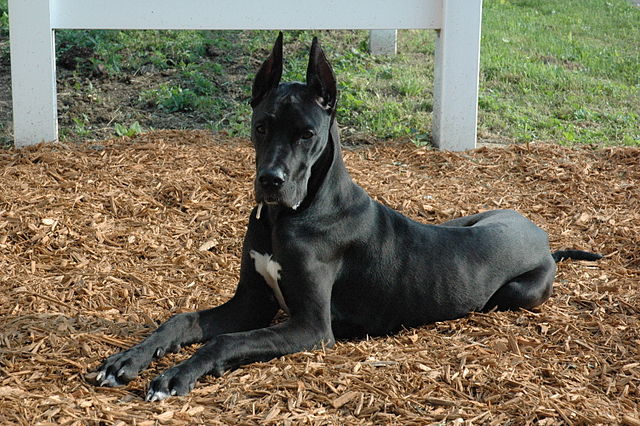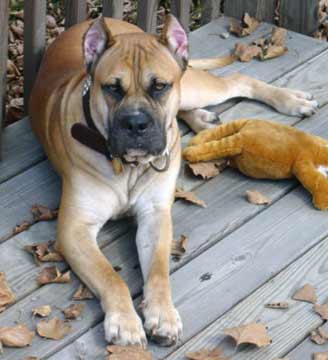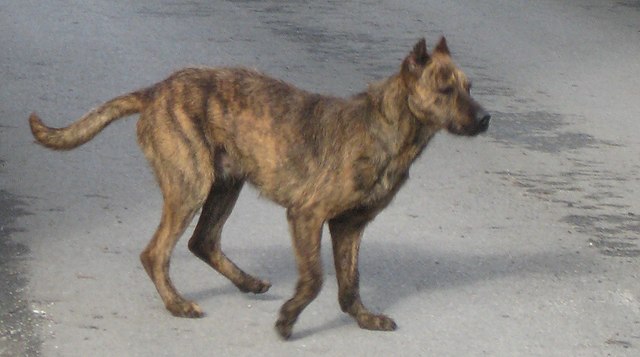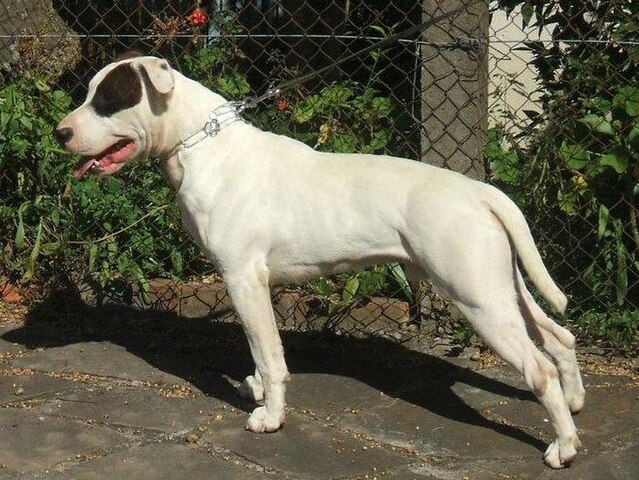The Great Dane is the national breed of Germany and holds a proud heritage as a boar-hunting dog. Rarely used for this original purpose nowadays, today they serve as both guard dogs and companions. Despite their giant size, this friendly breed is incredibly loving and gentle – making them excellent pets. Prospective owners should be prepared to socialize them extensively as puppies, and lay down firm household rules, if they expect them to reach their full potential. Well-socialized Danes are friendly and love to meet new people, although will retain a protective instinct when the situation calls for it.
Although they have been used as estate guards, Danes should never be expected to live completely outside. These are social animals that need plenty of indoor time with the family. When they are outside for play and potty time they should be kept in a secure fenced yard. Danes do best in homes that have enough room for them to stretch their legs, both inside and outside. This giant breed may also need a bigger-than-average car to ride around in. It can be difficult to fit a Dane into a compact car for vet trips! Upgrading the car is only one of the expenses of owning a giant dog – they eat more and generally cost more to maintain than smaller breeds.
Great Danes get along very well with children, although the children must be need to be taught to be polite (as with all dogs). Because of their size, it is not unusual for a Dane to knock over a toddler accidentally while zooming around. Parents of small children must supervise all interactions to be sure that nobody gets hurt. Because of their patience, most Danes are still able to live with even young children provided that the parents keep a steady watch, and know that a young dog is still likely to knock the kid down every now and again.
Unfortunately, Danes are predisposed to a number of health conditions including bloat, which is the #1 killer of the breed. Bloat involves the stomach filling with gas and then twisting, cutting off the blood supply. Studies have shown that bloat seems to have a genetic component, although there are certain environmental factors that also often come into play – such as exercising the dog right before or after eating. Danes are also at risk of cardiomyopathy and hip dysplasia, which means that puppies should only be acquired through reputable breeders that run health tests before breeding. Puppies bought from pet shops and backyard breeders are much more likely to have health issues. The average life expectancy of most Danes is 7-10 years.
Like most puppies, Great Danes can be destructive when they are young. The difference is… their size means that they can do a lot more damage to a house! It is not unheard of for an adolescent Dane to destroy couches, walls and doors while they were left alone unsupervised. For this reason, crate training is highly recommended, at least until they reach an age where they are less destructive. Make both travel and home life easier with the Petmate Vari Kennel – https://amzn.to/3B3CUE6
In addition, obedience training is an absolute must. A dog this big with no training or manners can be a disaster or even a liability to live with. Luckily, most Danes are eager to please and love learning! Although they tend to have stubborn streaks, overall this breed is quite trainable as long as the owner is consistent and understands that Danes may take a little bit longer than the “standard obedience breeds”.
Danes are athletic dogs requiring daily exercise. Despite their mellow nature, this is an energetic breed although most will not exercise themselves, even if they have a large yard. This means the owner needs to commit to regular walks. The one exception to this rule is when it comes to puppies. A puppy’s joints are not formed completely until they grow older, and therefore they should not be given forced exercise until the growth plates have closed. Furthermore, Danes shouldn’t be taken jogging until they are at least two years old. Although adults should ideally be walked at least once, if not several times a day, the walks do not need to be strenuous.
The smooth coat of the Great Dane doesn’t shed very much and is easy to care for. Twice a year the dog will blow the coat, meaning that there is more shedding, but this is rarely a problem for the majority of people as long as they increase the brushing during this time. Baths only need to be given when needed, and take very little time. Danes also need their nails trimmed throughout the month so as to not scratch floors and people. All in all, they are very low-maintenance when it comes to grooming.
Danes come in six recognizable colors – fawn, brindle, blue, black, harlequin (black patches on a white background) and mantle (black and white, marked like a Boston Terrier). Any other color is considered a disqualification. While mis-marks can show up in a litter, a prospective buyer should be wary of breeders intentionally breeding non-standard colors. Some colors, such as solid white, come with additional health problems so it’s best to buy only from responsible breeders who don’t breed strictly for “rare colors”.

Affiliate Disclaimer
As an Amazon Associate, I earn from qualifying purchases. This means that if you click on an affiliate link on this site and make a purchase, I may earn a small commission at no additional cost to you. Rest assured that I only link to products I have used, or use on a regular basis, and trust enough to recommend them to you!



